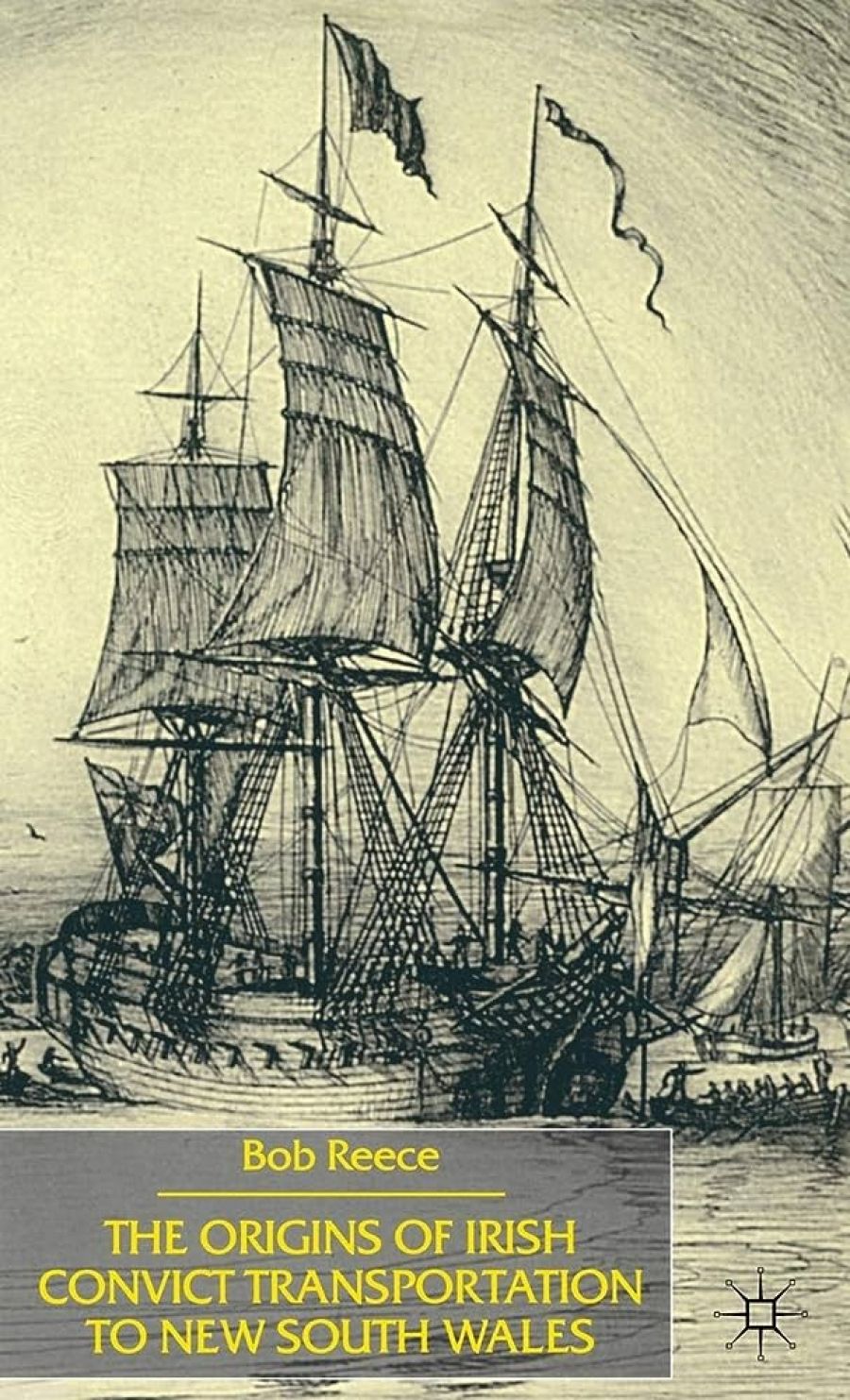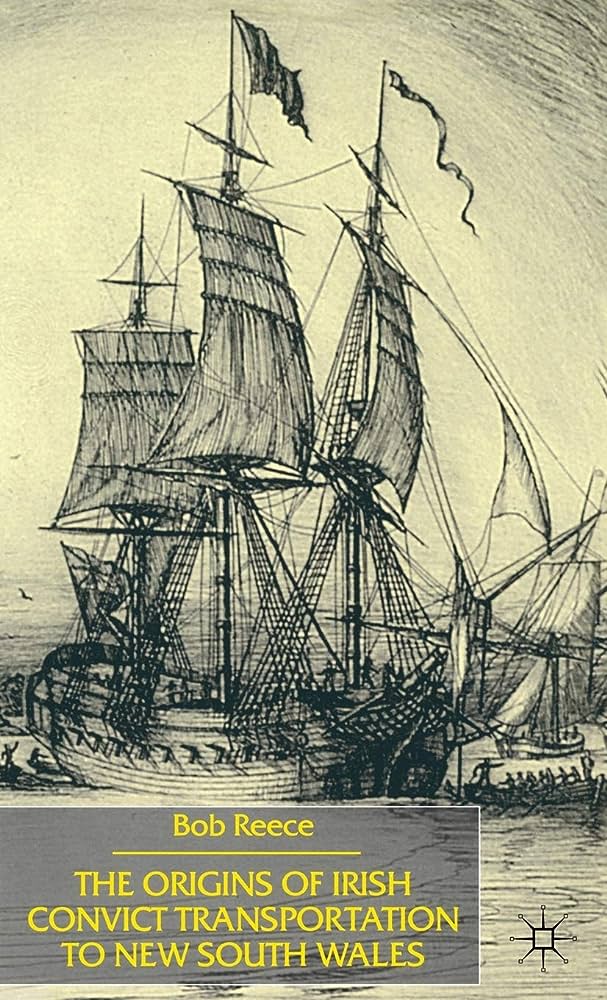
- Free Article: No
- Contents Category: Australian History
- Review Article: Yes
- Article Title: The Irish Empire
- Online Only: No
- Custom Highlight Text:
This book tells how the Irish government gradually rearranged its methods of convict transportation, from a variety of destinations in North America to a single destination on the far side of the world. The story takes place predominately between 1783 and 1791, from the independence of the United States (which effectively closed American ports to British and Irish transports) to the sailing of the Queen, the first ship to take convicts direct from Ireland to New South Wales. It is a subject that has never been properly examined, mainly because we tend to assume that the Irish point of view – as far as administration goes – was nothing more than a footnote to the British.
- Book 1 Title: The Origins of Irish Convict Transportation to New South Wales
- Book 1 Biblio: Palgrave, $57.20 pb, 373 pp
- Book 1 Cover Small (400 x 600):

- Book 1 Cover (800 x 1200):

The 1780s was one of the most extraordinary decades in European history. Because of its unusual perspective, this book casts a small but significant new light on that moment. We know the 1780s best as the period that witnessed American independence, including the creation of the federal constitution, and, in 1789, the beginning of revolution in France. These events, however tremendous in themselves, were symptomatic of something more vast. There were, throughout Europe and North America, extraordinary shifts in ideas on a number of fronts. As a small symptom, note, for instance, that one of the leading men in the new USA, Benjamin Rush, was also one of the founders of the new discipline of psychology. Revolutions and the rise and fall of states are big events, sure enough. But there was more to the 1780s than that.
From an Australian point of view, what mattered most about that decade was the way in which Europeans turned their minds to the way governments managed crime. Indeed, they seem to have been intrigued as to what crime was. This was not just a matter for intellectuals and officials. The newspapers of the time were full of details about lawbreaking and punishment, about criminals, judges and gaolers. Some of the most advanced brains began to work with new theories of management, dreaming up penal systems which, they thought, would transform convict personalities and make convict muscle useful to the state. Convict rights, by the same token, would be shaped by questions of material value. (The idea of ‘human resources’ has a long history.)
And yet, at the same time, leading lawyers also began to appear in court on behalf of common criminals, as they had rarely done before. The principle of ‘innocent until proven guilty’ was applied systematically for the first time. Ideas about delinquency were heading in at least two directions at once. The complex moral dramas that crime threw up – the wonderful contradictions between cunning and stupidity, poverty and wealth, violence and compassion – were a source of endless fascination and argument. For men and women of the 1780s, they seemed to go to the heart of the human condition.
Bob Reece focuses squarely on the 1780s and takes full advantage of the mass of written evidence that these new concerns produced. During the second half of the eighteenth century, and especially during the 1780s, government bureaucracy and the newspaper press both became much more energetic and pervasive. As a result, there is much raw material for the historian to work with. In this book, official documents are brought to light that have not been used in this way before. A good deal also comes from the Dublin newspapers. Historians have already trawled the London papers for evidence of early transportation to New South Wales, and Reece’s work makes for an important addition to their findings. Maybe he underestimates the amount of material printed in Dublin that had been purloined from the sister city. Not everything he quotes sounds completely original but, of course, this does not affect the impression it made among the Irish themselves.
A Dublin perspective gives a new depth to what we know about official attitudes to transportation. In fact, it gives a distinctive feel for the workings of empire. Histories that focus mainly on decision-making in London can easily fail to convey the sheer weight – the marble immensity – of imperial power. They dwell instead on the contrast between the subject considered in a vacuum. Stories about the to-and-fro between London and Dublin, especially told, as they are here, against the background of empire, give us something original. The government in Dublin was largely colonial. But it was also the government of one of the oldest nations in Europe. Ireland had its own aristocracy, its own bureaucracy, its own merchant class (interested, like the English, in transatlantic trade), its own professional and intellectual institutions, and its own public opinion. The Irish government was subject to the British government, and yet, from 1782 to 1801 (when it was abolished), the Irish parliament was, in theory, equal to the parliament at Westminster.
Bob Reece is lavish in his use of detail. We get a very good sense of the way the Irish penal bureaucracy worked, including the way it impacted on the poor. In many ways, it duplicated the English system, and yet it had its own habits and its own moral ethos. Reece tells of the chaotic inefficiency of the Irish prisons. They were bad in England, too, but, on balance, the problems seem to have been different. In Ireland – so it appears from this book – reformers had to cope mainly with corruption and lack of funds. In England, it was more often inertia and the power of vested interests.
Administrators in Ireland, when they set their heart on reform, had considerable room to move. Reece sometimes takes his lead from Oliver MacDonagh’s biography of the most eminent of Irish penal reformers, The Inspector General: Sir Jeremiah Fitzpatrick and the Politics of Social Reform, 1783–1802 (1981). Fitzpatrick, as that book shows, was able to remodel Irish prisons fairly effectively because the Irish government was less hedged about by ancient corporate bodies than the government in England, and because the Irish nobility and gentry were fairly feeble.
But, on the other hand, in England there was more money to spend. Reece gives a vivid impression of the way the Irish prisons were falling apart in the 1780s and of the simple failure of funds to improve them. In England, other things being equal, money could always be found to make necessary changes. Especially significant for this book is Ireland’s dependence on the English system of transportation. This was partly constitutional. The colonies to which convicts might go were British colonies, so that the Irish government could not use them without asking first. But, more fundamentally, the Irish government did not have the resources to initiate anything vaguely resembling transportation to a place so remote as New South Wales.
I mean financial resources, but the same could be said of moral and intellectual resources. This book throws into strong relief the fact that transportation to New South Wales was the initiative of a government of vast wealth, remarkable administrative skills and a kind of intellectual confidence which we still, two centuries later, find hard to come to terms with. Alan Frost, one of the most eminent writers about early settlement, has made this point, or something like it, in a number of books. What Bob Reece’s work does is to set us, as readers, immediately in Britain’s shadow. It was the Irish who felt most immediately the weight of British power, and it is the Irish perspective we get here. This is the Irish struggling, not very well for the most part, with the opportunities of empire.
The book is also an important comment on the complexity of the imperial enterprise. Reece shows how often the punishment of convicts was regulated by strict legal principle and by humanitarian concerns. The running of the convict system appears as a matter of national honour. And yet, at the same time, the stories he tells are thick with examples of callousness and brutality. The contradiction is not Reece’s fault. It is there in the evidence. Nor can it be dismissed as hypocrisy. Within the British Empire, and far beyond the 1780s, there was an extraordinary tension between the high idealism of government and the lived experience of the poor and powerless.
The 1780s were partly about justice, including justice for the poor. The story of the British Empire is a story of justice and injustice laid side by side, interwoven with considerable drama and complexity. While it does not really tackle these ambiguities, Reece’s book offers many good stories, honestly told, and much new evidence about the way Irish transportation worked. As such, it is an important milestone in our understanding of empire, and of Australian origins.


Comments powered by CComment